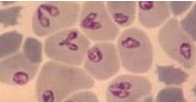In the process of walking the dog, if the dog likes to go to the grass or some bushes, it is likely to be bitten by ticks, and ticks, as an external parasite, can actually transmit some other diseases, among which the dog's
dog
There are two species of Babesia (also formerly called Babesia) that parasitize dogs: Babesia canis and Babesia gibseri.
The life cycle of Babesia must be completed by two hosts, and the result of the current study is that the tick is the only known terminal host.

cell diagram
Schizogene: Babesia enters the body with the saliva of the tick, then parasitizes in the red blood cells, and reproduces in the red blood cells. At this time, asexual reproduction is carried out, including: binary fission, which is divided into two parts by wood; budding
Gametogenesis: At this stage, sexual reproduction is carried out. Babesia enters the intestine of the tick with the bite of the tick, most of which die, and a small part develops into a radiator (spindle-shaped with flagella protrusions).
Sporogenesis: The zygote enters the tick's organ after repeated division and then enters the oocyte of the female tick. After the progeny tick matures and feeds, it enters the salivary gland, and sporulation occurs in the salivary gland.
From the life history of Babesia, we know that it has a great relationship with ticks, so the clinical incidence basically has a history of tick infection.
Dangers of Babesia:
1. Parasitic in red blood cells and multiply in them, destroy red blood cells, cause hemolytic anemia and cause jaundice (visible mucosal yellowing).
2. Due to the massive dissolution of red blood cells, the oxygen transport capacity of the body is reduced, the body's lack of nourishment causes breathing difficulties, systemic metabolic disorders and acid-base electrolysis imbalance, thus causing damage to various tissues and organs.
3. Babesia has the function of enzyme, which causes a large number of vasodilator active substances in the blood of animals, such as kallikrein, vasoactive peptide, etc., resulting in hypotensive shock syndrome.
4. Activates the coagulation system of animals, leading to vasodilation, congestion, hypoxia of system tissues and organs, and damage to organs
5. The accumulation of parasite toxins and metabolites in the body can act on the central nervous system and the autonomic nervous system, resulting in dysfunction of the central regulation of body temperature and disturbance of the autonomic nervous system, resulting in high fever and coma.
symptom:
1. Since the disease needs to be transmitted by ticks, ticks can often be found on the skin of animals, such as the base of the ear, the inner side of the forearm, the inner side of the thigh, and the bottom of the abdomen where the skin is thinner and less hairy.
2. Inexplicable fever, the body temperature is around 40-41 degrees, and it is mostly irregular intermittent heat.
3. Depressed spirit, like to lie down, weakness of limbs, loss of appetite or even abolishment, obvious weight loss
4. The conjunctiva is pale and yellow-stained, the fluid with unpleasant odor flows from the mouth and nose, the urine is yellow to dark brown, and the blood is thin
diagnosis:
1. Find ticks on animals
2. Have some of the above clinical symptoms, such as fever, pale and yellow mucous membranes, hemoglobinuria, etc.
3. Obvious anemia in laboratory examination (combined with blood smear: hemolytic anemia)
4. The blood smear found that Babesia was diagnosed
(Generally, there are two or more matches to be suspected)
Ticks
treat:
1. Quinoline urea sulfate: 0.5mg/kg subcutaneous or intramuscular injection.
2. Imidazophenyl urea: 5mg/kg is formulated into 10% solution and injected subcutaneously or intramuscularly, once every 24 hours
3. Bernier (triazamidine): 11mg/kg as a 1% solution for subcutaneous or intramuscular injection, once every five days
In medication, it is also necessary to do supportive therapy according to the specific clinical symptoms of animals.
At the same time, the way to prevent Babesia is to expel ticks, so regular extermination in vitro is very important, especially for those dogs who like to go to some grass.
